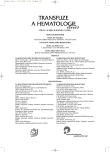Splenectomy in diagnostics and treatment of hematological disorders: A single-center indications, complications and results
Authors:
F. Kvapil 1; M. Doubek 1; Y. Brychtová 1; Z. Kala 2; J. Vorlíček 1; J. Mayer 1
Authors‘ workplace:
Interní hematoonkologická klinika, Fakultní nemocnice Brno
1; Chirurgická klinika, Fakultní Nemocnice Brno
2
Published in:
Transfuze Hematol. dnes,12, 2006, No. 3, p. 146-152.
Category:
Comprehensive Reports, Original Papers, Case Reports
Overview
Splenectomy represents a frequent therapeutic and diagnostic instrument in various hematological disorders. Retrospective analysis of patients who underwent splenectomy in Department of Internal Medicine and Hematooncology, Faculty Hospital Brno between 2000–2005 comprises 58 cases, 46 (79 %) of which were therapeutic, 12 (21 %) were diagnostic. Therapeutic indications: Idiopathic thrombocytopenic purpura (27 patients), autoimmune hemolytic anemia (6), thromobotic thrombocytopenic purpura (5), hairy cell leukemia variant (4) and less frequent diagnoses – thrombocytopenia in B-cell chronic lymphocytic leukemia, hypersplenism in myelodysplastic syndrome, splenic rupture due to aspergillosis in a patient with acute lymphoblastic leukemia, progression of T-cell peripheral lymphoma. Short-term therapeutic effect was achieved in 91 % of cases and remains 68 % in long-term follow-up. Splenectomy in predominant ITP patients was indicated in refractory disease, all the patients had been previously treated with corticosteroids and other immunosuppressants had been employed in 41 %. Long-term remission was observed in 74 % of patients, however additional 18 % of patients achieved good response with subsequent immunosuppressive therapy. In the other disorders therapeutic effectiveness was high as well. Most frequent findings in the diagnostic splenectomy group were non-Hodgkin lymphomas – splenic marginal zone lymphoma (3), diffuse large B-cell lymphoma (2), T-cell peripheral lymphoma, mantle cell lymphoma. Other diagnoses encompassed Hodgkin lymphoma, carcinoid tumor, and aspergillosis in patient with acute myeloid leukemia after allogenic stem cell transplantation. Complications were observed in 22 %, although most of them were of less severity. Serious complications occurred in 4 patients (7 %), invariably in laparotomic splenectomy. There were no reported deaths in connection with splenectomy.
Conclusion:
Splenectomy is relatively safe and efficient tool in hematology. In our experience we confirm results of other studies both in terms of effectivity (in ITP in particular) and low risk of the procedure.
Key words:
splenectomy, indication for splenectomy, complication of splenectomy, laparoscopic splenectomy, idiopathic thrombocytopenic purpura
Labels
Haematology Internal medicine Clinical oncologyArticle was published in
Transfusion and Haematology Today

2006 Issue 3
Most read in this issue
- Splenectomy in diagnostics and treatment of hematological disorders: A single-center indications, complications and results
- Plasma concentrations of cytokines and co-stimulatory molecules (interleukins IL-2, IL-4, IL-5, IL-6, IL-8, IL-10, IL-13, TNF-α, TGFβ1, sCD23, sCD40L and IL-6 receptor) in healthy blood donors
- The standardization of a biochemical laboratory determination of multiple myeloma
- New approaches to diagnosis and treatment of iron overload
